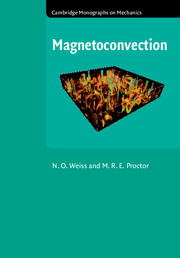Book contents
- Frontmatter
- Dedication
- Contents
- Preface
- 1 Introduction
- 2 Basic MHD
- 3 Linearized Boussinesq magnetoconvection
- 4 The nonlinear regime
- 5 2D Boussinesq magnetoconvection
- 6 3D Boussinesq magnetoconvection
- 7 Magnetoconvection, rotation and the dynamo
- 8 Compressible magnetoconvection
- 9 Solar and stellar magnetic fields
- Appendix A The Boussinesq and anelastic approximations
- Appendix B Chaotic systems
- Appendix C Double-diffusive convection
- Appendix D Magnetic buoyancy and the magneto-Boussinesq approximation
- References
- Index
9 - Solar and stellar magnetic fields
Published online by Cambridge University Press: 05 November 2014
- Frontmatter
- Dedication
- Contents
- Preface
- 1 Introduction
- 2 Basic MHD
- 3 Linearized Boussinesq magnetoconvection
- 4 The nonlinear regime
- 5 2D Boussinesq magnetoconvection
- 6 3D Boussinesq magnetoconvection
- 7 Magnetoconvection, rotation and the dynamo
- 8 Compressible magnetoconvection
- 9 Solar and stellar magnetic fields
- Appendix A The Boussinesq and anelastic approximations
- Appendix B Chaotic systems
- Appendix C Double-diffusive convection
- Appendix D Magnetic buoyancy and the magneto-Boussinesq approximation
- References
- Index
Summary
In this final chapter we focus on the interactions between convection, magnetic fields and rotation in stars that, like our Sun, possess deep outer convection zones, with the aim of relating theory to observations. Following on from the treatment of planetary dynamos in Chapter 7, we begin by considering the large-scale fields that are responsible for the solar cycle and survey attempts to model solar and stellar dynamos, ranging from mean-field dynamo theory to the results of the latest massive computations (Charbonneau 2010).
Then we turn to small-scale behaviour at the solar surface. Over the past two decades detailed observations – from the ground, from the stratosphere and from space – have revealed a wealth of detailed information about the structure and properties of magnetic features on the Sun and on other magnetically active stars. Although the idealized theoretical models that we have described in previous chapters do explain the general behaviour of magnetic fields at the surface of a vigorously convecting star, any more detailed confrontation of theory with observations demands a more precise description of the stellar plasma. Two properties are particularly important. The first is the role of ionization: in the Sun, hydrogen is ionized just below the visible photosphere, with resulting changes to the equation of state and the value of γ that affect the superadiabatic gradient and lead to the presence of a deep convection zone (Stix 2002).
- Type
- Chapter
- Information
- Magnetoconvection , pp. 320 - 348Publisher: Cambridge University PressPrint publication year: 2014



